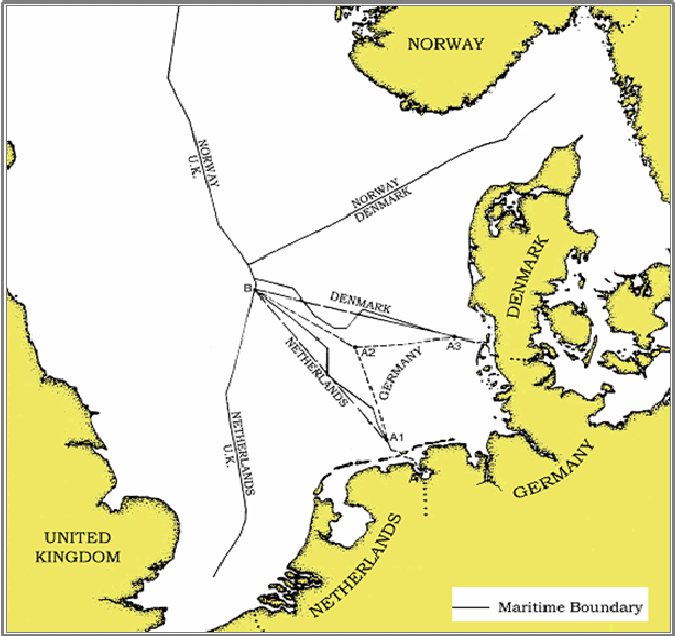The facts of these founding landmark cases are well known: the coastal
line along Denmark, the Federal Republic of Germany and the
Netherlands is concave with an almost rectangular angle of the German
coast situated between the other countries. It was this particularity that
caused the difficulties in the delimitation of the common and largely
homogeneous continental shelf of the North Sea. The Federal Republic of
Germany entered into agreements with the Netherlands and Denmark in
1964 and 1965 respectively, on the delimitation of small parts of the
common shelf outside territorial waters. These delimitations were mainly
based on equidistance. Beyond these mini-treaties, however, no settlement
was achieved and negotiations broke down. The Netherlands and
Denmark both insisted on the application of equidistance as the governing
principle for the delimitation of the entire boundary. The Federal
Republic refused to use such a principle on the ground that it would
result in an unacceptably limited shelf zone due to the overall concavity
of the coastal configuration. It would cause the boundaries of Denmark
and the Netherlands to intersect at a substantial distance from the
common boundary cross point of the shelves of the United Kingdom,
the Netherlands and Denmark, close to the centre of the North Sea. Some
13,000 square kilometres were in contention.
The matter was submitted to the ICJ in 1965, based on a tripartite
protocol and corresponding bilateral special agreements concluded
between the Federal Republic and the others. The parties did not ask
the Court to delineate the boundary. Rather, they asked it to expound
the ‘principles and rules of international law . . . applicable to the
delimitation’ between the parties in dispute. Before the Court, the
Netherlands and Denmark again argued that equidistance should
mandatorily apply as a rule of law. The Federal Republic, on the other
hand, argued that the correct rule to apply under the circumstances of the
case is one that would result in the allocation of a ‘just and equitable
share’ of the available continental shelf to all the coastal states. Such
allocation should be based upon the proportions of the coastal lengths or
the sea frontage. It emphasized that this approach was not a matter of
delimitation ex aequo et bono. Instead, the Federal Republic relied upon
the philosophical concept of justitia distributiva, known to each legal
system. In particular, the Federal Republic denied the legal nature of
equidistance and complained about the ‘cut-off’ effect caused by applying
this method in the present case.
The Court refuted the contentions and arguments of both parties. The
concept of distributive justice, or just and equitable apportionment, was
rejected on grounds that the case was not about apportionment, but
about delimitation of the shelf. The shelf, said the Court, already ipso
facto and ab initio, belongs to coastal states as a matter of natural
prolongation of the land territory. The Court went on to reject the
mandatory application of equidistance. Instead, the Court relied on the
model of equity and equitable principles, as introduced by the 1945
Truman Proclamation. It developed the model of equity and equitable
principles and set forth a number of criteria and factors to be taken into
account by the parties as a matter of legal obligation in subsequent
negotiations: the general configuration of the coasts of the parties; the
physical and geological structure and location of natural resources of the
shelf involved; the element of a reasonable degree of proportionality
between the continental shelf areas appertaining to the coastal state;
and the length of each state’s coast measured in the general direction of
the coastline.
The Court did not suggest a particular line or ad hoc construction for
the boundary. In 1971, the three states achieved a practical compromise
based on non-equidistance. The negotiated boundaries extended the
‘German corridor’ to the middle of the North Sea while respecting the
already-existing areas under exploitation (in particular the promising
Dan-Field) at the northern boundary with Denmark.

